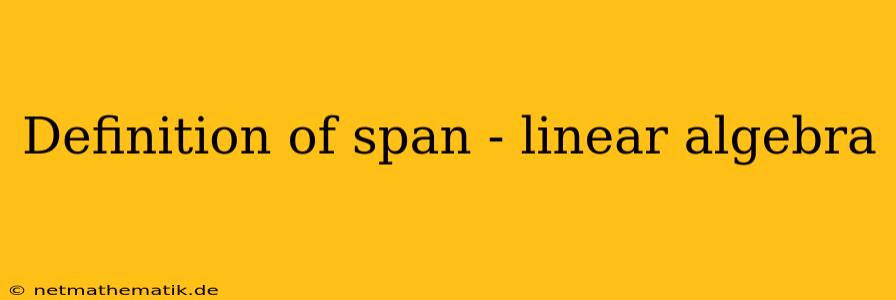In the realm of linear algebra, the concept of span is fundamental to understanding the relationships between vectors and the vector spaces they inhabit. It essentially describes the set of all possible linear combinations that can be formed from a given set of vectors. This idea underpins numerous applications in fields like physics, engineering, and computer science, where understanding the extent and scope of vector relationships is crucial. This article delves into the definition of span in linear algebra, providing a thorough exploration of its key aspects, properties, and practical implications.
Understanding the Definition of Span
The span of a set of vectors, denoted as Span{v1, v2, ..., vn}, is the collection of all possible linear combinations that can be formed using those vectors. In simpler terms, it represents the set of all vectors that can be reached by scaling and adding the original vectors.
Formal Definition
Formally, the span of a set of vectors {v1, v2, ..., vn} in a vector space V over a field F is defined as:
Span{v1, v2, ..., vn} = {c1v1 + c2v2 + ... + cnvn | c1, c2, ..., cn ∈ F}
This definition states that the span consists of all vectors that can be expressed as a linear combination of v1, v2, ..., vn, where the coefficients c1, c2, ..., cn are elements of the field F.
Visualizing Span
To grasp the concept of span intuitively, let's consider a few simple examples:
-
Span of a single vector: If we have a single vector v in a two-dimensional space, its span would be a line passing through the origin and in the direction of v. This is because any scalar multiple of v would lie on this line.
-
Span of two linearly independent vectors: If we have two linearly independent vectors in a two-dimensional space, their span would be the entire plane. This is because any linear combination of these two vectors can reach any point in the plane.
-
Span of three linearly independent vectors: In a three-dimensional space, the span of three linearly independent vectors would be the entire space.
Properties of Span
The span of a set of vectors exhibits several important properties:
-
Closure under addition: If u and v are in Span{v1, v2, ..., vn}, then u + v is also in Span{v1, v2, ..., vn}. This property ensures that the span is closed under vector addition.
-
Closure under scalar multiplication: If u is in Span{v1, v2, ..., vn} and c is a scalar, then cu is also in Span{v1, v2, ..., vn}. This property ensures that the span is closed under scalar multiplication.
-
Subspace: The span of a set of vectors is always a subspace of the original vector space. This means that the span itself forms a vector space with its own set of vectors.
Determining Span
To determine the span of a set of vectors, we can follow these steps:
-
Express the vectors in a matrix form: Create a matrix where each column represents one of the given vectors.
-
Perform row operations: Use elementary row operations to reduce the matrix to row echelon form or reduced row echelon form.
-
Identify the pivot columns: The columns corresponding to the pivots in the reduced matrix indicate the linearly independent vectors that form a basis for the span.
-
Express the span: The span of the original set of vectors is the same as the span of the linearly independent vectors identified in step 3.
Applications of Span
The concept of span finds applications in numerous areas, including:
-
Linear independence: The span of a set of vectors can be used to determine if the vectors are linearly independent. If the span of the vectors is equal to the entire vector space, then the vectors are linearly independent.
-
Basis: A set of vectors that spans the entire vector space is called a basis. The span helps in finding a basis for a given vector space.
-
Solving systems of linear equations: The solution set of a system of linear equations can be expressed as the span of a set of vectors.
-
Data analysis: The span can be used to understand the range of possible data points generated by a set of variables.
Conclusion
The span of a set of vectors is a fundamental concept in linear algebra, providing a powerful tool for understanding the relationships between vectors and the vector spaces they occupy. It helps us determine linear independence, find bases, solve systems of linear equations, and analyze data. The ability to grasp and manipulate span is essential for anyone seeking to delve deeper into the rich landscape of linear algebra.
